Long Beans: More Than Just Long! Unlocking Their Uses, Benefits, and Delicious Dishes
Step into any Asian market, and you’re likely to spot them: incredibly long, slender green pods hanging in bunches. These are yardlong beans (Vigna unguiculata subsp. sesquipedalis), a fascinating and delicious legume popular in many cuisines. While often called long beans, asparagus beans, or Chinese long beans, their impressive length is just the beginning. This guide explores the many yardlong beans uses, dishes, and health benefits, showing you why they deserve a place in your kitchen.
What Exactly Are Yardlong Beans?
Despite their resemblance to common green beans (Phaseolus vulgaris), yardlong beans belong to a different species and are actually a subspecies of the cowpea. They are known for their distinct characteristics:
- Appearance: Typically 1 to 1.5 feet long (though they can grow up to a yard!), slender, and flexible. They range in color from light to dark green.
- Taste and Texture: They have a milder, slightly sweeter taste than green beans, with a unique grassy note. When cooked quickly, they offer a delightful crunchy-yet-tender texture that holds up well, unlike green beans which can become limp. They become softer with longer cooking.
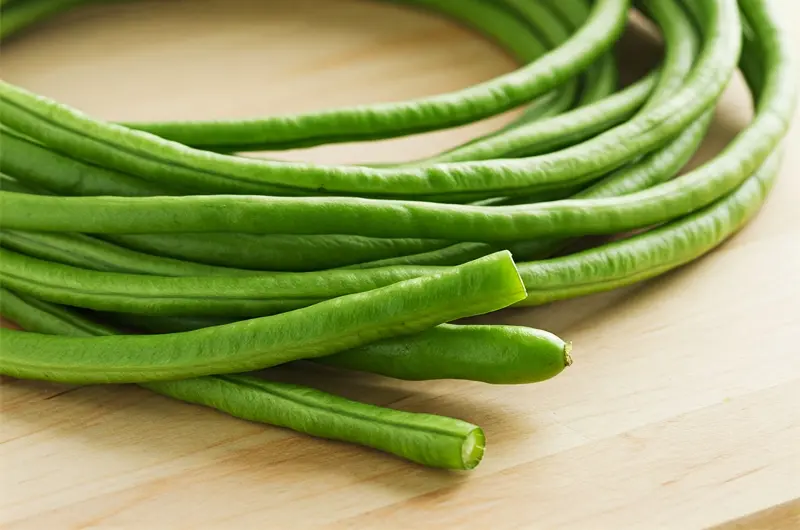
The Impressive Health Benefits of Long Beans
Beyond their culinary appeal, incorporating long beans into your diet offers several nutritional advantages:
Packed with Essential Nutrients
Yardlong beans are a good source of essential vitamins and minerals. They provide Vitamin C (important for immune function), Vitamin A (crucial for vision and skin health), and Folate (vital for cell growth). They also contain minerals like potassium, magnesium, and manganese.
Good Source of Dietary Fiber
Like many legumes, long beans contribute valuable dietary fiber. Fiber is essential for digestive health, helping to regulate bowel movements, prevent constipation, and potentially contribute to healthy cholesterol levels.
Rich in Plant Compounds
These beans contain various beneficial plant compounds, including antioxidants. Antioxidants help combat oxidative stress in the body, which is linked to various chronic diseases.
Supporting Overall Wellness
The combination of fiber, vitamins, and minerals found in long beans supports overall health, contributing to everything from energy metabolism to maintaining healthy blood pressure (thanks to potassium).
Culinary Uses: How to Cook with Yardlong Beans
The versatility of yardlong beans makes them a fantastic ingredient. Their structure lends itself particularly well to certain cooking methods.
Best Cooking Methods for Long Beans
- Stir-frying: This is arguably the most popular method. Quick cooking over high heat preserves their crisp texture and vibrant color. Cut them into bite-sized pieces (often 1-2 inches) for even cooking.
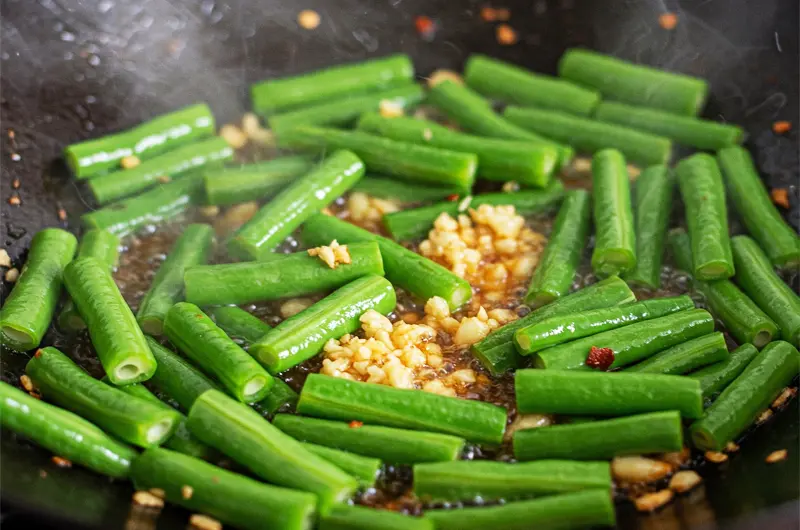
- Sautéing: Similar to stir-frying but can be done at slightly lower heat, often with aromatics like garlic and ginger.
- Steaming/Blanching: Briefly steaming or blanching helps retain nutrients and achieve a tender-crisp texture, perfect for salads or simple side dishes. Avoid overcooking.
- Braising/Stewing: While they can become softer, adding them towards the end of cooking in curries or stews allows them to absorb flavour without turning mushy.
Flavor Pairings
Yardlong beans pair beautifully with bold Asian flavours:
- Garlic, ginger, scallions
- Soy sauce, oyster sauce, fish sauce
- Chili peppers, chili paste (like Sambal Oelek)
- Sesame oil
- Proteins like pork, chicken, beef, shrimp, and tofu
Preparation Tips
Preparing long beans is simple:
- Wash the beans thoroughly under cold running water.
- Pat them dry.
- Trim off the tough stem ends and the wispy tips.
- Cut them into desired lengths – typically 1-to-2-inch segments are versatile for most dishes. Cutting on the diagonal can look appealing.
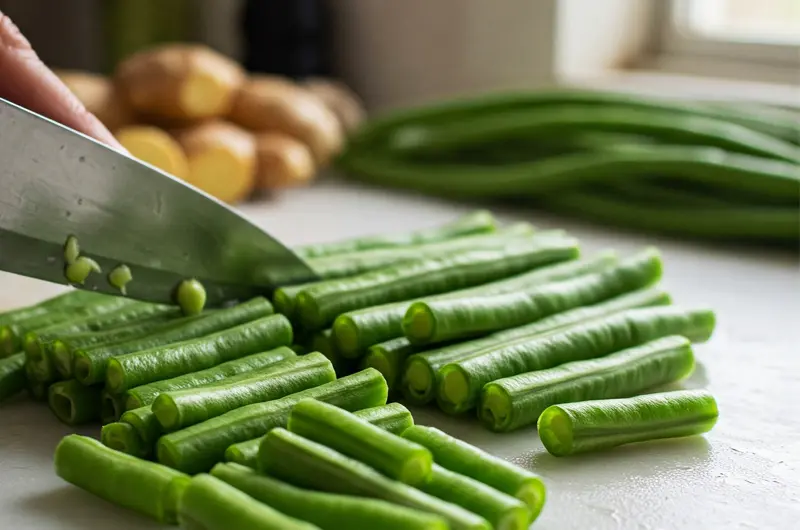
Delicious Yardlong Bean Dishes from Around the World
These beans feature prominently in many cuisines, especially across Asia. Here are some examples of popular yardlong bean dishes:
Classic Stir-Fried Long Beans
Perhaps the most common use, stir-frying long beans with garlic is a simple classic. Variations include adding minced pork, dried shrimp, fermented black beans, or chili for heat. This is a staple in Chinese and Southeast Asian cooking.
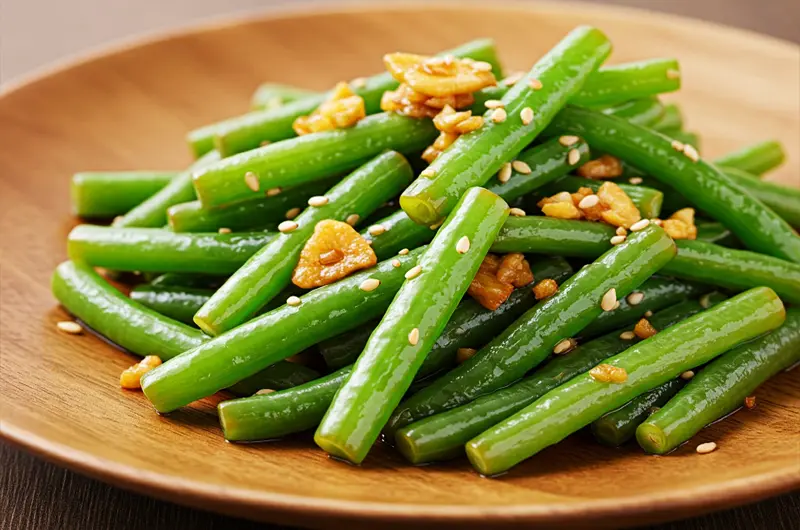
Long Beans in Curries and Stews
They add texture and absorb flavour wonderfully in coconut-based curries (like Thai Green Curry) or savory stews. A famous Filipino dish is Adobong Sitaw (Long Beans Adobo), where they are braised in a vinegar-soy sauce mixture.
Long Beans in Salads
Blanched or steamed long beans add a pleasant crunch to salads. They are a common component in the Indonesian salad Gado-Gado, served with a rich peanut sauce. They can also be simply dressed with sesame oil, soy sauce, and a touch of vinegar.
Added to Soups and Noodle Dishes
Cut into smaller pieces, long beans can be added to soups or noodle dishes towards the end of cooking to add colour, texture, and nutrients without becoming overly soft.
Selecting and Storing Your Long Beans
To ensure the best flavour and texture:
What to Look For When Buying
Choose beans that are firm, plump, and flexible. They should have a vibrant green colour (unless it’s a purple variety) and be free from brown spots, blemishes, or shriveling. Younger, more slender beans are often preferred for their tenderness.
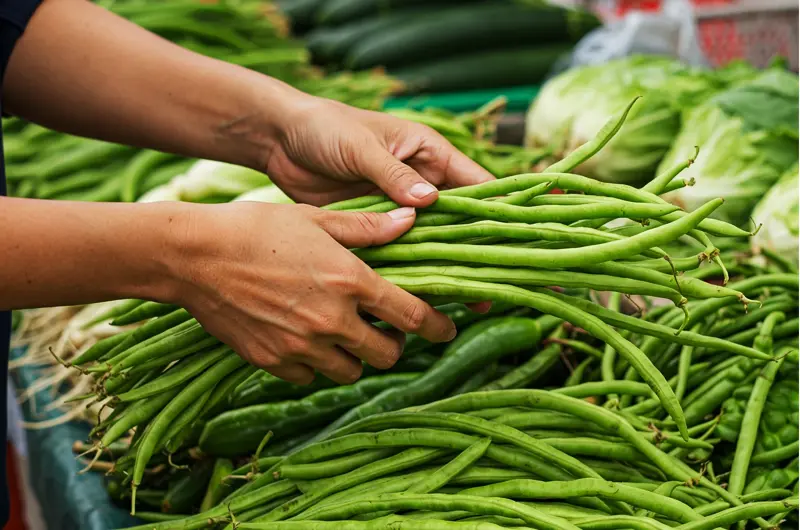
How to Store Long Beans
Store unwashed long beans in a perforated plastic bag or a loosely closed bag in the crisper drawer of your refrigerator. They are best used within 3-5 days for optimal freshness and crispness.
Yardlong beans are much more than just their impressive length. They offer a unique texture, a mild and pleasant flavour, valuable nutrients, and incredible versatility in the kitchen. From quick stir-fries to flavourful stews and refreshing salads, exploring the many uses and dishes featuring yardlong beans is a delicious culinary adventure. Don’t hesitate to pick up a bundle on your next market trip!
Read More about Yardlong Bean: Grow Long Beans: Your Guide to Yardlong Bean Success
Latest Posts:

